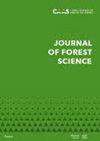外来木本物种在低地河岸森林栖息地的分布和环境影响:在南高加索格鲁吉亚保护区的案例研究
IF 1.1
Q3 FORESTRY
引用次数: 0
摘要
生物入侵是全球公认的as aÂ严重威胁toÂ本地生物多样性,asÂ它们可以改变本地生态系统的结构、组成和功能ofÂ。TheÂ河岸森林isÂ被认为是aÂ高度入侵的栖息地byÂ入侵植物,因为河流通过陆地生态系统为外来物种提供了asÂ走廊orÂ可能只是庇护了无法在其他地方生存的外来物种。TheÂ河岸森林,as aÂ高保护价值森林,is anÂ重要组成部分ofÂ低地森林ofÂ格鲁吉亚。这些森林分布在大河沿岸,包括Mtkvari、Alazani、Iori、Aragvi、Ksani、Algeti和大、小Liakhvi河。在这里,weÂ提供了aÂ案例研究,这是ofÂ科学项目的一部分,题为“调查ofÂ潜在入侵外来木本物种(PIAWS) inÂ保护区ofÂ格鲁吉亚”。保护区(PAs) inÂ格鲁吉亚发挥anÂ重要作用inÂ保护本地生物多样性,包括森林生态系统ofÂ独特的生物多样性。WeÂ重点关注onÂ两个保护区内沿Mtkvari河和Iori河分布的低地河岸森林(LRF) - Korugi和Gardabani管理保护区(MRs)。研究区主要鉴定出6种外来木本植物(AWS) inÂ:刺槐刺槐(Robinia pseudoacacia)、皂荚(Gleditsia triacanthos)、Ailanthus altissima、黑槭(Acer negundo)、紫穗槐(Amorpha fruticose)和桑树(Morus alba)。theseA AWS之间的局部状态r.a. pseudoacacia, G.A triacanthos,一位altissima,和一位后isA入侵,而一位牡未知领域和硕士alba isA加入美国籍。TheÂ环境影响of AWS on LRFÂ生境评价采用EICAT (environmental impact Classification for Alien Taxa)分类系统。AÂ主要orÂ中等影响of AWS on LRFÂ生境isÂ明显,根据to EICAT影响机制,isÂ表达了asÂ明显竞争和物理、结构和间接影响。西娅的研究显示,影响水平三个AWS, r.a. pseudoacacia, G.A triacanthos,和一位altissima asA分类主要是奥拉温和(“有害”的影响),而其余AWS,一位牡和一位后,小奥拉未知领域最小的问题。AWS inÂ入侵地区ofÂ和LRFÂ是在as anÂ的下层发现的,否则,它们已经形成了主要的冠层,取代了本地的优势木本物种。因此,不良的结构和演取过程inÂ入侵lrf是明显的。本文章由计算机程序翻译,如有差异,请以英文原文为准。
Distribution and environmental impact of alien woody species in lowland riparian forest habitats: Case study in the protected areas of Georgia, South Caucasus
Biological invasions are globally recognised as a significant threat to native biodiversity, as they can change the structure, composition, and functioning of the native ecological system. The riparian forest is considered a habitat highly invaded by invasive plants since rivers serve as corridors for alien species through the terrestrial ecosystem or may simply harbour exotic species that cannot survive elsewhere. The riparian forest, as a high conservation value forest, is an important part of the lowland forests of Georgia. These forests are distributed along large rivers, including the Mtkvari, Alazani, Iori, Aragvi, Ksani, Algeti, and Great and Little Liakhvi rivers. Here, we present a case study that was part of the scientific project titled 'Survey of Potential Invasive Alien Woody Species (PIAWS) in the Protected Areas of Georgia'. Protected areas (PAs) in Georgia play an important role in conserving native biodiversity, including forest ecosystems of distinguished biodiversity. We focused on the lowland riparian forest (LRF) distributed along the Mtkvari and Iori rivers within two PAs – Korugi and Gardabani Managed Reserves (MRs). Six main alien woody species (AWS) were identified in the study areas: Robinia pseudoacacia, Gleditsia triacanthos, Ailanthus altissima, Acer negundo, Amorpha fruticose and Morus alba. Among these AWS, the local status of R. pseudoacacia, G. triacanthos, A. altissima, and A. fruticosa is invasive, while that of A. negundo and M. alba is naturalised. The environmental impact of AWS on LRF habitat was evaluated using the Environmental Impact Classification for Alien Taxa (EICAT) classification system. A major or moderate impact of AWS on the LRF habitat is evident, which, according to EICAT impact mechanisms, is expressed as apparent competition and physical, structural and indirect impacts. The study revealed that the impact levels of three AWS, R. pseudoacacia, G. triacanthos, and A. altissima, were classified as major or moderate ('harmful' impact), while the remaining AWS, A. negundo and A. fruticosa, were of minor or minimal concern. AWS in the invaded areas of the LRF are found as an understorey layer or, otherwise, they have already formed the main canopy and replaced native dominant woody species. Therefore, undesirable structural and succession processes in invaded LRFs are evident.
求助全文
通过发布文献求助,成功后即可免费获取论文全文。
去求助
来源期刊

Journal of forest science
Forestry-
CiteScore
2.30
自引率
9.10%
发文量
48
审稿时长
6 weeks
期刊介绍:
Original results of basic and applied research from all fields of forestry related to European forest ecosystems and their functions including those in the landscape and wood production chain are published in original scientific papers, short communications and review articles. Papers are published in English
 求助内容:
求助内容: 应助结果提醒方式:
应助结果提醒方式:


